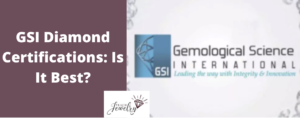Diamond Certifications
Buying a diamond is all about having the confidence the one you choose is worth the price. Many shoppers are wary of the industry and feel the diamonds they’re shown are overpriced and don’t match the quality the sales person tells them.
Diamond certificates are a way to solve this problem, but it’s important to not place your trust in a grading report from just any organization.
Gemological Science International (GSI) is the newest prominent diamond certifier, and many sellers display its certificate to prove the authenticity of its quality.
We’ll discuss what you should know about GSI, the types of certificates its offers, how to read its grading reports, how it impacts price, and whether you should buy a GSI diamond.
What is a GSI Certificate?
GSI is a for-profit diamond certifying organization that prides itself as the only major gem lab formed in the 21st century. It’s headquartered in New York City but has offices around the world.
Its primary customers are retail diamond chains such as Zales, Jared, and Kay, so it’s common to see these companies showcasing their diamonds with a GSI certificate.
One reason for this partnership is because they offer a faster turnaround on grading. Retail stores want to buy and resell their diamonds as quickly as possible, so GSI can serve that market by ensuring the inventory is available for sale to customers sooner than other certifiers.
GSI does more than routine diamond certifications. They promote additional services such as analyzing the grades of the cut and a diamond’s light performance to diamond origin testing and laser inscription.
But the core service of GSI, like its competitors, is grading a diamond for its quality across the primary characteristics of cut, clarity, color, and carat.
In this area, the GSI isn’t considered as reliable or consistent as the preeminent certifying institutions such as the Gemological Institute of America (GIA) and the American Gem Society (AGS).
Many in the industry see their grading standards as loose, so if you sent two diamonds of the same quality, you could get two results. The same would be true in sending two identical diamonds to GSI and either the GIA or AGS.
The grades given on the report directly impact the price it’s listed for, so paying for a diamond that’s of lesser quality than on the certificate means you’re overpaying.
Types of GSI Certificates
GSI offers many types of certificates that vary in the amount of information provided about the diamond. The reports for every diamond they’ve graded are located online, so you can verify a report on its website to know if it’s legitimate.
The most complete report is the Full Diamond Examination Report (FDX). The FDX includes the important characteristics such as:
- Carat weight
- Shape and cut
- Measurements
- Clarity
These are areas you’d find on any reputable diamond report because they’re the areas on which price is based.
The next type of GSI certificate is an Intermediate Diamond Examination Report (IDX). It offers similar information as the FDX but is 6.75” x 5” in a bifold document.
One notable difference is the IDX doesn’t always include a clarity plot. A clarity plot shows the placement and types of inclusions on a diamond.
This allows the buyer to know which imperfections as present, whether cloudiness, feathers that look like fractures, or twinning wisps.
An even smaller version of a report is the Special Diamond Examination Report. It includes the measurements, carat weight, shape, color, clarity and a photo. It’s just 3.75” x 2.75” in letter head format, so you’ll rarely see these displayed at a retailer.
The Modified Diamond Examination Report is smaller than an index card and only includes the essential information about a diamond. It should go without saying you shouldn’t buy a diamond with this little information on its quality.
GSI also offers certificates on lab-grown diamonds and colored gems.
The lab-grown reports include the same type of information you’d expect on a natural diamond. The value of a lab-grown versus natural diamond is significant, so the report clearly labels it as lab-grown.
For colored gemstones, the Full Gemstone Examination Report is the same type of report as the FDX. It includes shape, color, clarity, and more. The other versions of the natural diamond reports are also available for colored gemstones.
How to Read a GSI Certification
If you’re considering a diamond graded by GSI, you should know how to read the certification. We’ll use the example of an FDX report for an ideal cut diamond.
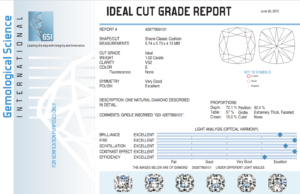
Four Cs
The four Cs of clarity, cut, color, and carat are the most influential factors in determining a diamond’s quality and price. These grades are listed together at the top of the report, and this diamond is graded as:
- Cut: Ideal
- Carat: 1.02
- Clarity: VS2
- Color: E
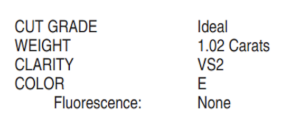
These indicate the diamond is high quality, because it earned the highest cut grade, is “eye-clean” at very slightly included, and is one grade short of a completely colorless diamond.
It’s weight does add a premium to the price because you’ll pay disproportionately more for a diamond that’s just more than one carat compared to one just below.
Clarity Plot
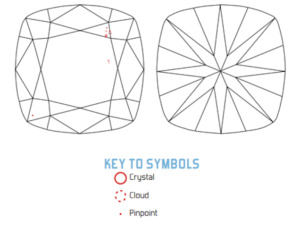
The clarity plot in the upper righthand corner of the GSI certification shows the diamond has crystals, clouds, and pinpoints.
You can see these are minor inclusions appearing on top of the diamond that wouldn’t impact its appearance or light performance to the naked eye.
Other Grading Information
GSI certifications include more than the four Cs and clarity plots. You’ll also see the diamond’s grades for:
- Symmetry and polish
- Proportions
- Inscriptions
- Fluorescence
- Light analysis
The light analysis is a unique feature of GSI reports. You won’t find these from most other diamond certifiers, and GSI counts it as one of their special offerings.

It rates the diamond’s brilliance, fire, scintillation, contrast effect, and efficiency. Together, they determine the light performance of a diamond and how much it sparkles.
Light performance is primarily impacted by the quality of the diamond’s cut, so it’s not surprising an ideal cut, that’s also colorless with minimal inclusions, scores highly in this area.
In other instances, GSI will include a comparison marker that shows the grade of an “average diamond.” You shouldn’t solely rely on this chart to learn about the diamond’s light performance because there isn’t a clear understanding of that average diamond’s quality.
How Does a GSI Certification Impact Diamond Prices?
A GSI certification generally results in a better deal for the retailer than the customer. Retailers are incentivized to earn the highest grade possible for their diamonds at the lowest price and fastest turnaround, and GSI steps in to serve this need.
Some in the diamond industry consider GSI to be a less reliable and consistent grader than other certifiers, so retailers are more likely to earn the grade that commands a higher price for the consumer.
For example, if GSI grades a diamond’s clarity as VVS2 (very, very slightly included), and its color as F (colorless), the GIA or AGS may give it a VS1 clarity and G color.
A diamond with the grades from GSI (left) would cost about $5,120. A diamond with the grades from the GIA (right) would cost about $6,460.
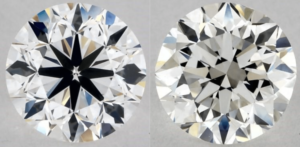
It would be the same diamond, but the certificates state it’s a different quality.
The consumer would be charged more for the grades given by GSI because GSI determined it was a higher quality diamond. That shows the importance of an accurate grade because it directly impacts the price the consumer pays.
In many instances, you’ll find GSI diamonds selling for less than GIA diamonds, all else being equal. That’s because the industry knows the GIA is considered the premium grader, so they can’t charge the same amount.
GSI Versus Other Diamond Certifiers
GSI is one of a number of diamond certifiers providing their services to diamond sellers.
The certifying organization that graded the diamond you’re considering significantly impacts its price and your ability to determine a fair one, so you should know how GSI compares to its competitors.
GSI vs. GIA
The GIA is considered the most reliable diamond certifier. They’re a nonprofit that provides some of the industry’s best research and education on gems.
The GIA is credited with developing the four Cs.
We recommend buying a diamond that’s been graded by the GIA. You’ll have confidence in the grades it receives, and it’ll also serve you well if you resell the diamond later.
You’ll often pay a premium for a diamond certified by the GIA compared to its competitors, but the peace of mind is worth knowing you haven’t overpaid for a diamond that’s actually of lower quality.
GSI vs. AGS
The AGS is also considered one of the preeminent institutions for grading diamonds.
The AGS stands next to the GIA in terms of consistency and reliability. While the GIA is considered the top certifier, you can have peace of mind with an AGS certificate as well.
They’re known for correctly assessing the quality of a diamond, and if you send a diamond to both the GIA and AGS, you’ll likely receive the same grade.
GSI vs. EGL
The European Gemological Laboratory (EGL), like GSI, is a for-profit diamond certifier with offices all around the world. They provide similar services, with their core offering being diamond grading certificates that measure the four Cs, proportions, symmetry, and more.
The industry generally puts GSI and the EGL in similar categories of having less strict grading systems than the GIA and AGS. You can expect a diamond to receive higher grades from GSI and the EGL, which means they could sell at a higher price than they’re worth.
GSI vs. IGI
The International Gemological Institute (IGI) is another popular diamond certifying organization that has its roots connected to large retailers. They’re also known for grading lab-grown diamonds.
Similarly to GSI, they offer a faster, less expensive alternative to diamond grading compared to the GIA and AGS.
GSI standards are known to be looser than the IGI, so diamonds graded by the former would often receive a higher grade. They’re known to grade diamonds at a higher quality, so they’ll sell for a higher price.
It’s important to remember it’s not in your best interest to have the grades inflated by whoever grades it, because you could end up with the same diamond, only likely at a higher price.
GSI vs. GCAL
Should You Buy a GSI Diamond?
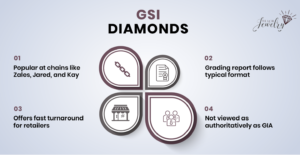
We recommend buying a diamond based on the GIA, GCAL, or AGS certificate, but if you do buy a GSI diamond, make sure you understand the report and that its grades align with the diamond’s appearance and quality.
Trust is the ultimate currency for many buyers with such a significant purchase, and it’s important to have confidence in a diamond’s quality and its price.
If the grades on its report don’t match the real quality of the diamond, it’s likely you’ll overpay. Opt for a certificate from a preeminent organization, and you’ll have confidence the grades on the report match the quality of the diamond.

Jacob Clarke
Jacob Clarke is the founder of TeachJewelry.com.
He earned an Applied Jewelry Professional Diploma from the Gemological Institute of America (GIA) and now brings you essential information about diamonds, settings, and more.
Jacob has consulted with leading jewelry brands, and his work has been cited in Clean Origin, Diamond Nexus and industry publications.
He's also a member of the International Gem Society.
He enjoys discussing jewelry with readers, so contact him with any questions at jacob.clarke@teachjewelry.com.

